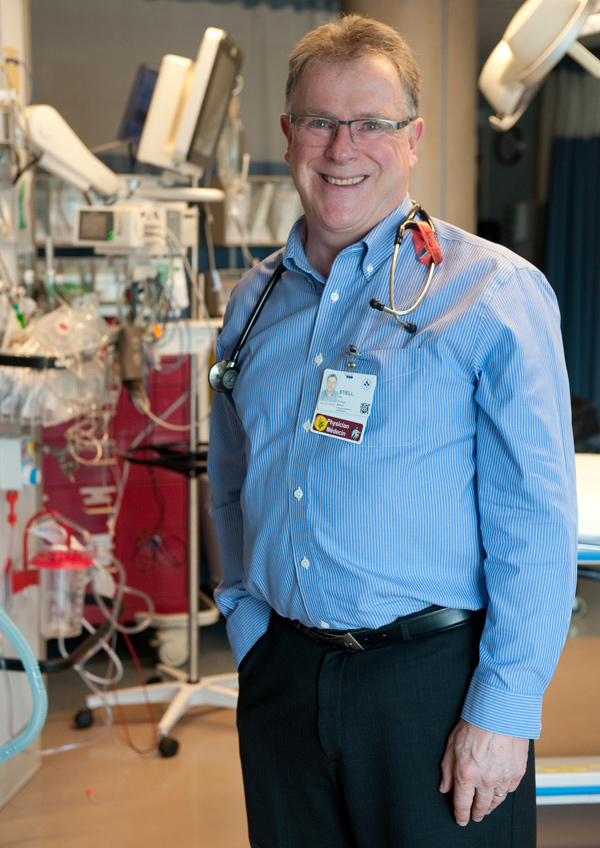Dr. Ian Stiell leads The Ottawa Hospital Emergency Medicine Research Group and is an active emergency room physician and clinical epidemiologist. His research has changed the way emergency room doctors across the world diagnose certain patients. Funnily enough, it almost didn’t happen. His mother thought he was too “squeamish” to be a doctor so he never considered medicine as a career until he got to university, enrolled in math (“it wasn’t so exciting after all”), and transferred to biology.
A successful career trajectory involves a lot of hard work and a bit of good timing. When Dr. Stiell was a med student, the field of emergency medicine was just emerging. Prior to the 1970s, physicians on a rotating basis staffed hospital emergency departments. It takes a unique set of personality traits to be an emergency room doctor.

“We have very short attention spans,” quips Dr. Stiell, describing himself and his fellow emergency room physicians. “We want to fix things right away, and we’re stimulated by the fact that people are coming constantly and we need to sort them out and deal with them very quickly. So I think that appeals to a lot of us, the action-oriented types.”
Dr. Stiell describes his early days as the era of “eminence-based” medicine. Young doctors simply did what the older doctors told them to do. Happily for all of us, we’ve moved into an evidence-based age.
Dr. Stiell had been in practice for a few years when he decided to take on a Masters of Epidemiology, an area of medicine that studies diseases – how often they occur in different groups of people and how they can be controlled – knowledge that plays a major role in public health. Of course, a master’s degree requires a thesis, and a thesis requires research.
“I needed to do a thesis which required me to collect a lot of patient data in a very short period of time,” explains Dr. Stiell. “In those days, we saw ankle sprains all day long and I knew that we really didn’t pay much attention to them.”
There was no shortage of data. He was able to study 750 patients over six months at the Civic and the General Campuses. That research was the foundation of the Ottawa Ankle Rules. These are “clinical decisions rules,” which result in a better, research-based way for medical professionals to diagnose medical problems.
Imagine a series of Yes/No questions. The Ottawa Ankle Rules consist of a list of questions the doctor asks the patient (such as, “Can you walk?”), while checking specific areas on the foot to assess the degree of pain. The answers determine whether the patient needs an X-ray or can go home.
If a patient with a sprained ankle is sent home, it frees up medical staff, and space, for other patients. This is especially important in smaller hospitals with limited personnel. “Ninety per cent of patients who have twisted their ankle just have a sprain and the X-ray will be normal,” explains Dr. Stiell.
The Ottawa Ankle Rules are now part of medical school curriculum and known around the world, but more importantly, as Dr. Stiell explains, they were also “the seedling that started a whole program of decision rules that we’re now studying.”
Clinical decision rules are the ideal way to expedite other conditions that tend to create higher volumes in emergency rooms and decision rules have been developed for conditions that are far more serious than a sprained ankle. Dr. Stiell has also been part of the team which developed the Ottawa Knee Rule, the Canadian CT Head Rule (for patients with minor head injuries and possible concussions), the Canadian C-Spine Rule (which helps physicians determine which trauma patients need imaging for potential cervical spine fractures), and, more recently, The Canadian Heart Failure Risk Scale and the Ottawa COPD Scale for patients with Chronic Obstructive Pulmonary Disease.
“These are more complex cases where we’re trying to decide whether to admit the patient to the hospital because that’s a burden for the patient and for the health care system,” explains Dr. Stiell. “We have so few beds, so we’re trying to provide some objective guidance for doctors as to who really needs to be in the hospital.”
Other doctors and researchers at The Ottawa Hospital are working on their own decision rules. Dr. Jeff Perry, for example, has been developing clinical rules regarding TIAs. A transient ischemic attack (TIA) occurs when blood flow to part of the brain is suddenly reduced by a blood clot. Early treatment can help prevent a stroke. Dr. Venkatesh Thiruganasambandamoorthy has been developing rules for fainting, or syncope, because patients who faint might have a serious underlying heart condition.
“It’s how you identify those cases that are the needle in the haystack,” says Dr. Stiell.
Since the introduction of the Ottawa Ankle Rules, fewer ankle sprains are showing up in the emergency room. Dr. Stiell speculates some patients might be self-diagnosing (with a search for “Ottawa Ankle Rules” on YouTube, for example), or that walk-in clinics – which don’t usually have quick access to X-ray machines – have implemented the rules too.
Knowing how much research goes into medical care, even into something as seemingly mundane as a sprained ankle, should be reassuring for Ottawa residents. It’s just one more thing that sets The Ottawa Hospital apart from other hospitals.
“I think if they come to The Ottawa Hospital they’ll know the doctors here are using the most up-to-date techniques and often are well ahead of the curve because of the research environment they’re exposed to here,” says Dr. Stiell.
“We’re trying to base our practice on good solid evidence and in this field – emergency medicine – it’s new and there’s relatively little evidence, so the fact that more and more, we’re creating good evidence to help patients is great. I hope that continues for a long time.”
